- What is Lawn Scarification and Why is It Important?
- What Are the Benefits of Scarifying in the UK?
- When is the Best Time to Scarify a Lawn in the UK? - When To Scarify Lawn?
- When Not to Scarify Your Lawn?
- When Should I Scarify My Lawn for the First Time?
- How Often Do I Need to Scarify My Lawn?
- Selecting the Right Scarifier for Your Lawn
- How to Prepare Your Lawn for Scarification?
- How to Scarify Your Lawn Properly?
- Scarifying Once vs Twice a Year – When Is It Necessary?
- No Grass Left After Scarifying – What to Do Next?
- How to Fix a Bare Lawn After Scarification?
- What to Do After Scarifying Your Lawn?
- How to Help Your Lawn Recover Faster?
- Top Tips and Advice for Lawn Scarification
- Common Mistakes to Avoid When Scarifying a Lawn
- Conclusion
Lawn scarification is a crucial practice for maintaining a healthy and vibrant lawn. Over time, thatch and moss accumulate on the surface, forming a dense layer that restricts air, water, and nutrients from reaching the soil. If left unchecked, this buildup can weaken the grass, encourage disease, and promote moss growth.
Scarifying is the process of removing this thatch layer, allowing the grass to breathe and grow more effectively. However, timing is critical—scarifying at the wrong time can do more harm than good. This guide will explain:
- What lawn scarification is and why it’s important.
- When to scarify lawn in the UK.
- How often should scarification be done?
- Which tools are best for the job?
By following the correct scarification techniques and timing, you can promote healthier, greener grass and improve your lawn’s overall appearance.
What is Lawn Scarification and Why is It Important?
Lawn scarification is the process of removing organic debris such as thatch, moss, and dead grass from the surface of the lawn. This is done using a scarifier or rake, which pulls up the unwanted material, improving airflow and allowing nutrients to penetrate the soil.
Over time, lawns naturally accumulate thatch—a dense layer of dead plant material. While a small amount of thatch (less than 1cm) is beneficial, too much can cause:
- Poor water drainage, leading to waterlogging.
- Restricted root growth, weakening the lawn.
- Increased moss and weed infestation.
What are Difference Between Scarification and Dethatching?
Scarification and dethatching are often confused, but they serve slightly different purposes:
| Process | Purpose | Depth of Treatment | Tools Used |
| Scarification | Removes surface-level thatch and moss | Light to moderate | Spring tine rake, electric/petrol scarifier |
| Dethatching | Removes deep thatch layers and compacted soil | Deeper | Heavy-duty dethatching rake, power dethatcher |
Scarification is a gentler method suitable for annual lawn maintenance, whereas dethatching is more intensive and needed less frequently.
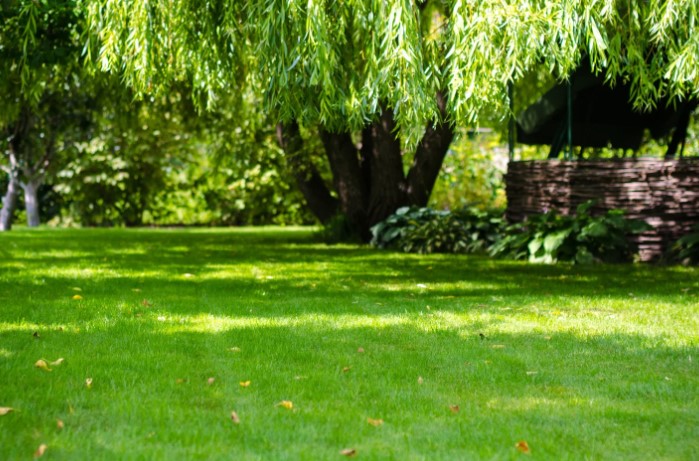
What Happens if You Don’t Scarify Your Lawn?
A lawn that isn’t scarified regularly can suffer from poor health and slow growth. Some common issues include:
- Thick thatch buildup, which blocks water and nutrients from reaching the roots.
- Increased moss growth, as moss thrives in compacted conditions.
- Weaker grass roots, making the lawn more susceptible to drought and disease.
- Uneven growth, resulting in patchy or sparse grass coverage.
Regular scarification ensures your lawn remains lush, aerated, and healthy.
What Are the Benefits of Scarifying in the UK?
Scarification offers numerous benefits for lawns, particularly in the UK, where cool temperatures and frequent rainfall create conditions for moss and thatch buildup.
Key Benefits of Lawn Scarification
- Removes Thatch and Moss – Thatch blocks essential nutrients and water from penetrating the soil. Scarification breaks up this layer, helping the grass access what it needs.
- Improves Aeration and Drainage – Removing surface debris allows better airflow and prevents waterlogging, which is common in UK gardens.
- Encourages Stronger Root Development – When the lawn is free of excess thatch, roots grow deeper, making the grass more resilient to dry conditions and heavy foot traffic.
- Prepares Lawn for Healthy Seasonal Growth – Scarifying in spring encourages fresh grass shoots, while autumn scarification removes summer thatch and prevents moss buildup over winter.
A well-scarified lawn is healthier, more resilient, and visually appealing throughout the year.
When is the Best Time to Scarify a Lawn in the UK? – When To Scarify Lawn?
Timing is essential for successful scarification. The two best seasons for scarifying are spring and autumn, but the approach differs slightly depending on the time of year.
When to Scarify a Lawn in Spring?
Spring scarification is ideal for young and growing lawns because it encourages fresh grass growth after winter. However, it should be done lightly to avoid damaging the grass.
- Best months: Late March to early May.
- Ideal conditions: The grass should be actively growing, and the weather should be mild but not too dry.
- Purpose: To remove light thatch and promote new grass growth.
If scarifying in spring, avoid going too deep, as the lawn needs time to recover before summer.
Learn how and when to prune hebe with our beginners guide.
When to Scarify a Lawn in Autumn?
Autumn is the preferred season for deep scarification because the lawn has more time to recover before winter dormancy.
- Best months: September to early October.
- Ideal conditions: The soil should be damp but not overly wet, and the temperature should be mild.
- Purpose: To remove summer thatch buildup and moss before winter.
Autumn scarification is deeper and more aggressive, as the lawn does not need to withstand heat stress like in summer.
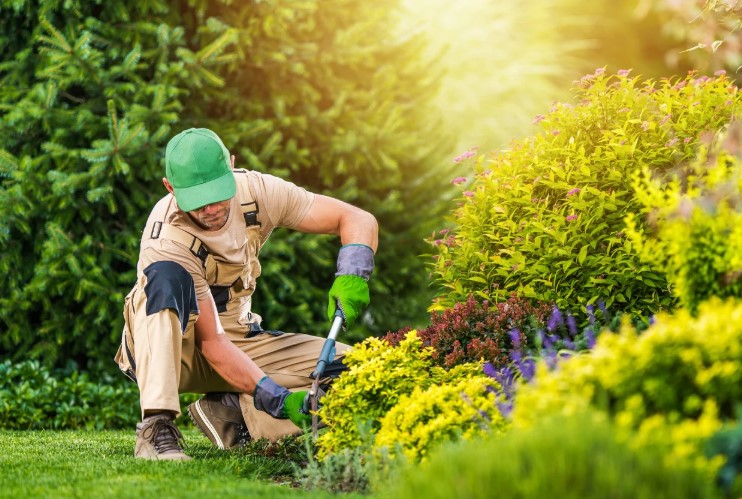
When Not to Scarify Your Lawn?
Scarifying at the wrong time can damage the lawn rather than improve it. Avoid scarification in the following conditions:
- During extreme summer heat – Grass struggles to recover, and the soil dries out quickly.
- In winter or when frost is expected – The cold slows down grass growth, leaving the lawn exposed and weak.
- If the lawn is new (less than a year old) – The roots are still developing and may not withstand scarification.
- After applying weed killers – Chemicals can weaken the grass, making it more vulnerable after scarification. Wait at least three weeks after applying treatments.
Scarifying under these conditions can lead to patchy, weak grass or bare soil, requiring months of recovery.
When Should I Scarify My Lawn for the First Time?
If you have recently established a lawn, you should wait at least 12 months before scarifying. Scarifying too soon can disrupt root development and damage young grass.
- Choose a mild season such as spring or autumn for the first scarification.
- Start with light scarification to test how well the lawn responds.
- Monitor grass recovery before planning deeper scarification.
For newly seeded lawns, gentle scarification with a spring tine rake is best rather than using a mechanical scarifier.
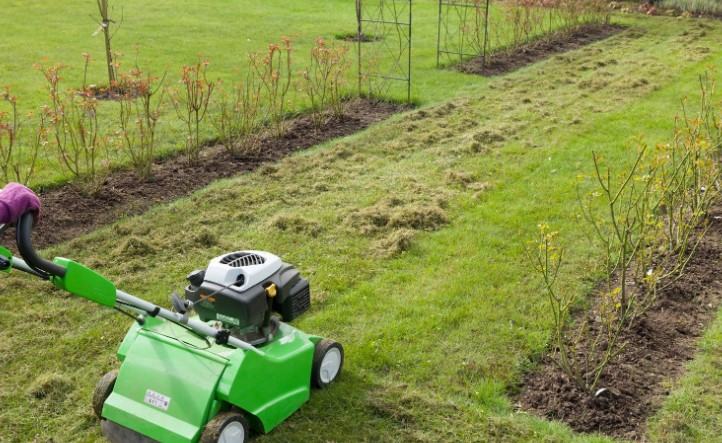
How Often Do I Need to Scarify My Lawn?
Scarification frequency depends on lawn condition and thatch buildup.
| Lawn Condition | Recommended Scarification Frequency |
| Well-maintained lawn | Once a year (light scarification) |
| Thatch-prone lawn | Every 1-2 years (moderate scarification) |
| Heavily thatched lawn | Every 2-3 years (deep scarification) |
If moss and thatch accumulate quickly, annual light scarification will help maintain a healthy lawn.
Selecting the Right Scarifier for Your Lawn
Name a Few Scarifying Tools
Choosing the right scarifying tool depends on your lawn size and condition.
| Tool Type | Best For |
| Spring tine rake | Small lawns, light scarification |
| Manual scarifier | Budget-friendly option |
| Electric scarifier | Medium-sized lawns |
| Petrol scarifier | Large gardens, deep scarification |
For small gardens, a manual scarifier or rake is sufficient. For larger lawns, an electric or petrol-powered scarifier is more efficient.
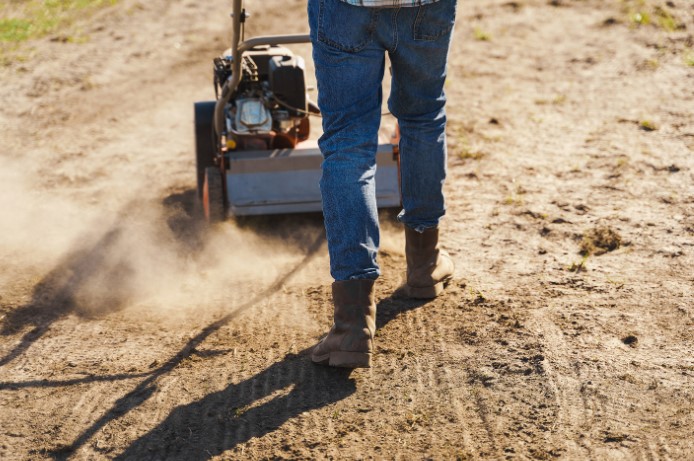
How to Prepare Your Lawn for Scarification?
Before scarifying your lawn, proper preparation is essential to ensure the best results. Without preparation, scarification can shock the grass, leading to uneven growth or even bare patches. Taking a few preparatory steps will help minimise stress on the lawn and promote a quicker recovery.
1. Mow the Grass Short (But Not Too Short)
A day or two before scarification, mow your lawn to a short but safe height—typically around 2.5 to 4 cm. Cutting it too short can expose the roots and make the grass more vulnerable to damage, while leaving it too long can make scarifying less effective.
2. Apply Moss Killer If Needed
If your lawn has a significant moss problem, apply a moss killer two to three weeks before scarifying. This ensures that the moss is fully dead before being removed, reducing the risk of spreading spores. Look for a moss treatment that contains iron sulphate, as it is particularly effective at killing moss while also strengthening the grass.
3. Water Lightly If the Soil Is Dry
Scarifying on dry, compacted soil can cause damage to grass roots. If the ground is too dry, water it lightly a day before to soften the surface. However, avoid overwatering, as excessively wet soil can make scarification too aggressive and cause unnecessary damage.
4. Rake Lightly to Loosen Debris
Before scarifying, use a spring tine rake to loosen the top layer of thatch. This helps the scarifier work more efficiently and prevents excessive pulling on the grass. If the thatch layer is thicker than 1 cm, consider aerating the lawn beforehand to improve oxygen flow to the roots.
How to Scarify Your Lawn Properly?
Once your lawn is prepared, it’s time to scarify correctly. The goal is to remove dead organic material without damaging healthy grass.
Choosing the Right Scarifying Tool
The choice of scarifier depends on your lawn size and the level of thatch buildup.
- For small lawns or light scarification, a spring tine rake or manual scarifier is sufficient.
- For medium-sized gardens, an electric scarifier makes the job easier.
- For large gardens with heavy thatch, a petrol-powered scarifier provides deeper penetration and greater efficiency.
Step-by-Step Scarification Process
- Start with a light pass – Adjust the scarifier settings to remove only the top layer of thatch.
- Scarify in multiple directions – First, go in one direction, then pass over again at a right angle to ensure even thatch removal.
- Remove the debris – Rake up and clear out all loosened moss and thatch.
- Overseed if needed – If the lawn looks thin after scarifying, spread grass seed over bare areas to encourage regrowth.
- Water and fertilise – To help the lawn recover, apply a high-phosphorus fertiliser and water the lawn lightly.
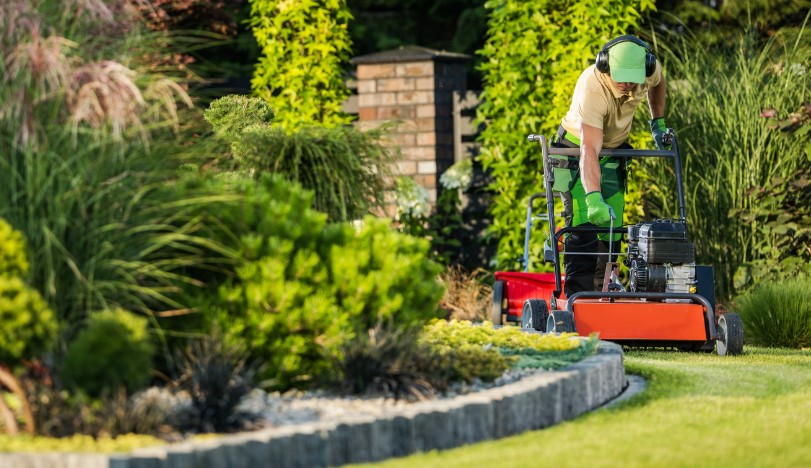
Scarifying Once vs Twice a Year – When Is It Necessary?
- Light scarification can be done once a year (spring or autumn).
- Deep scarification should only be done every 2-3 years, especially if thatch is a major issue.
- Lawns with excessive moss may require twice-yearly scarification, once in spring and again in autumn, to fully control moss growth.
No Grass Left After Scarifying – What to Do Next?
Sometimes, after scarifying, the lawn may appear patchy or even completely bare. This can happen if:
- Too much thatch was removed at once.
- The lawn was weak before scarification.
- Scarification was done at the wrong time.
If you’re left with little to no grass, don’t panic—your lawn can recover with the right steps.
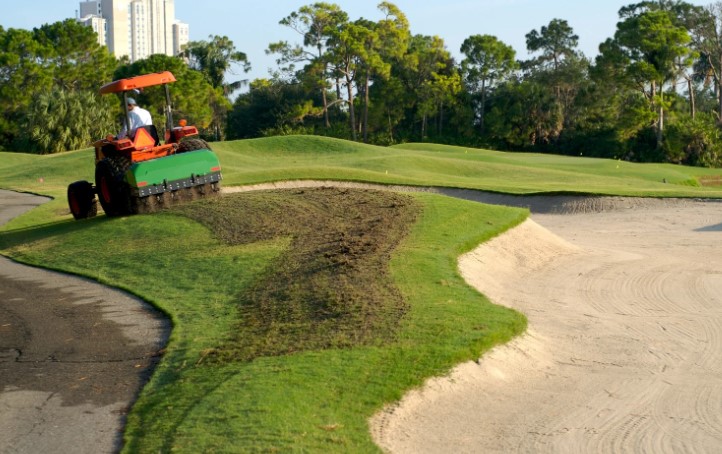
How to Fix a Bare Lawn After Scarification?
1. Overseeding Is Crucial
Spreading high-quality grass seed over the affected areas will fill in bare patches and restore the lawn’s density. Choose a fast-growing seed mix suited to your lawn type.
2. Apply Lawn Feed to Boost Regrowth
Using a high-phosphorus lawn fertiliser will encourage strong root development and speed up the recovery process. Look for a product specifically designed for post-scarification recovery.
3. Keep the Soil Moist (But Avoid Overwatering)
Grass seedlings need consistent moisture to germinate and establish roots. Lightly water the lawn daily for the first two weeks after overseeding, ensuring the soil remains damp but not saturated.
4. Be Patient – Full Recovery Takes 4-6 Weeks
A properly scarified and overseeded lawn takes time to recover. Within four to six weeks, new grass will begin to fill in, and your lawn will look healthier than before.
What to Do After Scarifying Your Lawn?
Once scarification is complete, aftercare is just as important as the process itself. Proper post-care ensures the lawn recovers quickly and grows back thicker and greener.
How to Help Your Lawn Recover Faster?
1. Overseeding to Fill in Bare Patches
After scarification, some areas may look thin. Overseeding ensures new grass fills in these gaps, preventing weeds and moss from taking over.
2. Applying Fertiliser to Promote New Growth
Use a fertiliser with a high phosphorus content, as this helps strengthen roots and support new grass shoots. Avoid nitrogen-rich fertilisers immediately after scarification, as they promote leaf growth over root development.
3. Watering and Care Tips for the Next Few Weeks
- Water lightly every day for the first two weeks after overseeding.
- Avoid walking on the lawn to prevent soil compaction.
- Mow only at the time, when the new grass reaches around 5-7 cm.


Top Tips and Advice for Lawn Scarification
- Scarify in the right season – Choose spring or autumn for the best recovery.
- Start lightly if it’s your first time – Going too deep can shock the grass.
- Follow up with overseeding and fertilisation – This ensures quicker regrowth.
- Avoid over-scarifying – Removing too much thatch at once weakens the lawn.
Common Mistakes to Avoid When Scarifying a Lawn
1. Scarifying at the Wrong Time
Scarifying in summer or mid-winter can stress the grass, leading to slower recovery or even grass loss.
2. Removing Too Much Thatch at Once
Heavy scarification can leave the lawn bare. If your lawn has thick thatch, consider light scarification over two seasons instead of one deep session.
3. Not Preparing the Lawn Properly
Skipping mowing with lawn mower, moss treatment, or pre-watering can make scarification less effective.
4. Forgetting Aftercare Steps
Not overseeding, fertilising, or watering slows recovery and can leave the lawn vulnerable to weeds and moss.
Conclusion
Scarification is one of the most effective ways to maintain a healthy lawn, but timing and preparation are key.
Recap: Best Time to Scarify
- Spring (March-May) – Light scarification to encourage new growth.
- Autumn (September-October) – Deep scarification to remove moss and thatch.
Key Takeaways
- Prepare your lawn before scarification for better results.
- Choose the right scarifier for your lawn size and condition.
- Always follow up with overseeding and fertilisation for faster recovery.
By following the guide on when to scarify lawn, how & what is the best time to rake UK and with the correct scarification methods, your lawn will grow back thicker, healthier, and greener, ensuring a beautiful garden all year round.


0 Comments